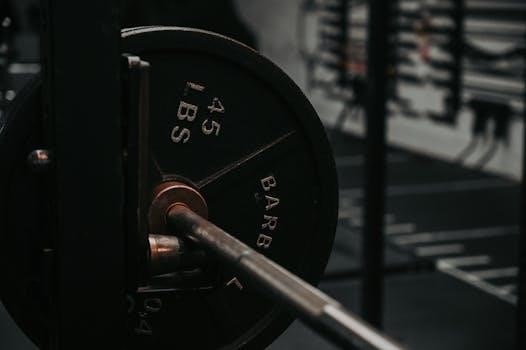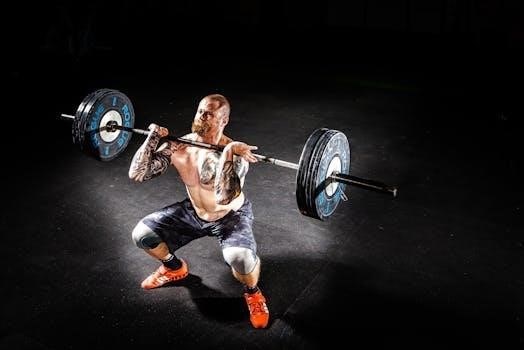Understanding Powerlifting Routines
Powerlifting routines are structured programs designed to increase strength in the squat, bench press, and deadlift. These routines often prioritize compound movements and can be physically and mentally taxing, emphasizing progressive overload and structured training.
What is a Powerlifting Routine?
A powerlifting routine is a meticulously planned training regimen focused on enhancing maximal strength in the three core powerlifting lifts⁚ the squat, the bench press, and the deadlift. These routines typically involve a combination of heavy compound exercises, accessory work, and strategic periodization. Unlike bodybuilding programs that prioritize muscle hypertrophy, powerlifting routines are specifically geared towards increasing the lifter’s one-repetition maximum (1RM) in these key lifts. They often incorporate lower rep ranges and higher intensities, with a strong emphasis on proper form and technique. A well-structured routine will also include deload periods to allow for recovery and prevent overtraining. The ultimate goal of a powerlifting routine is to prepare the lifter to perform at their peak during competition or for personal strength achievements, all while minimizing the risk of injury.
Key Components of a Powerlifting Program
A successful powerlifting program incorporates several essential components to maximize strength gains. Firstly, the core of any program lies in the three primary lifts⁚ the squat, bench press, and deadlift. These are typically trained with varying intensities and rep ranges throughout the training cycle. Accessory exercises play a crucial role, targeting specific muscle groups to support the main lifts and address any weaknesses. Periodization is another vital aspect, involving the systematic variation of training volume and intensity to optimize progress and prevent plateaus. Proper form and technique are paramount to ensure safety and effectiveness. Recovery, including adequate rest and nutrition, is just as important as the training itself. Finally, a good powerlifting program should be tailored to the individual’s needs, experience level, and goals. This can involve adjusting exercise selection, training frequency, and intensity.

Types of Powerlifting Programs
Powerlifting programs vary, catering to different experience levels and goals. They range from beginner-friendly templates to advanced routines, with some emphasizing pure strength and others blending hypertrophy with powerlifting principles.
Beginner Powerlifting Programs
Beginner powerlifting programs typically focus on building a solid foundation of strength and technique in the three core lifts⁚ squat, bench press, and deadlift. These programs often involve simple, linear progression, where the weight is gradually increased each workout or week. They may utilize rep ranges that allow for learning and practicing proper form, often with sets of 5 repetitions (5×5) or 3 repetitions (3×5). Many beginner programs also incorporate accessory exercises to strengthen supporting muscles and prevent injury. Popular options include the “Starting Strength” program, the r/fitness basic beginner routine, and modified versions of the 5/3/1 method. These routines will usually have a lower training volume, giving the body a chance to adapt to the stresses of lifting. Additionally, programs like GZCL’s methodology can be adapted for beginners. The main goals are to learn the lifts and build a base level of strength.
Intermediate Powerlifting Programs
Intermediate powerlifting programs are designed for lifters who have established a base level of strength and proper lifting technique. These programs often introduce more complex training methodologies, such as periodization, where the training intensity and volume fluctuate over time. They may include variations of the main lifts, such as paused squats or close-grip bench presses, to address specific weaknesses. Intermediate programs also tend to incorporate more accessory exercises, tailored to address individual needs. Many utilize RPE (Rate of Perceived Exertion) to gauge intensity, allowing for more flexible training. Popular intermediate programs include variations of the 5/3/1 program, GZCL methodology, and the Sheiko programs. These programs increase training volume and intensity compared to beginner routines, incorporating more varied rep ranges and sets. The focus shifts from simply learning the movements to optimizing strength gains and preparing for competition.
Powerbuilding Programs vs. Pure Powerlifting Programs
Powerbuilding programs blend elements of powerlifting and bodybuilding, aiming to increase both strength and muscle mass. These programs typically include the core powerlifting movements (squat, bench, deadlift) alongside hypertrophy-focused exercises with higher rep ranges. Conversely, pure powerlifting programs solely concentrate on maximizing strength in the three competition lifts. They often prioritize lower rep ranges and heavier weights, with less emphasis on muscle growth. Powerbuilding programs might incorporate more accessory work for muscle development, while pure powerlifting routines focus on movements that directly improve the main lifts. The volume and intensity in powerbuilding are often higher than in pure powerlifting, due to the added focus on hypertrophy. Ultimately, the choice between these programs depends on individual goals⁚ powerbuilding if you want both size and strength, and pure powerlifting for maximal strength in the three lifts.

Popular Powerlifting Templates
Many popular powerlifting templates exist, such as 5/3/1, and GZCL, offering structured approaches. These programs are available as templates for various experience levels, focusing on strength gains.
5/3/1 Program Overview
The 5/3/1 program is a popular powerlifting template known for its simplicity and effectiveness in building strength. It revolves around a four-day training split, focusing on the main lifts⁚ squat, bench press, deadlift, and overhead press. Each workout features one of these main lifts, and the program is based on percentages of your one-rep max, calculated using a training max slightly lower than your actual max to allow for progression. The program uses a 4-week cycle, with each week focusing on a different rep scheme (5 reps, 3 reps, and 1 rep) followed by a deload week. It allows for personalized accessory work to address individual weaknesses and preferences. Many free templates are available online, and the program’s adaptability makes it suitable for various experience levels, from beginners to advanced lifters, when implemented carefully. It is considered highly productive, especially in a caloric surplus.
GZCL Programming Methodology
GZCL is a flexible powerlifting programming methodology, created by Cody Lefever, that emphasizes a tiered approach to training. It’s known for its adaptability and its focus on both strength and hypertrophy. The method uses a system of Tiers, where Tier 1 exercises are the main powerlifts (squat, bench, deadlift, overhead press), performed with a focus on heavy weights and lower reps. Tier 2 exercises typically involve variations of the main lifts or other compound movements, performed with moderate weights and reps. Tier 3 exercises are accessory movements that target specific muscle groups or address weaknesses. GZCL programming is highly customizable and allows lifters to adjust exercises and volume based on their own needs and progress. The flexibility and personalized nature of the GZCL method, along with readily available templates, makes it suitable for lifters of all experience levels who want to gain strength.
Considerations for Female Powerlifters
Female powerlifters may need to consider specific factors when choosing or adjusting their training programs. Due to generally lower testosterone levels, females might respond differently to certain training volumes and intensities compared to male powerlifters. Some may find that programs designed by accomplished female lifters, such as Jennifer Thompson or Megsquats, are more suitable for their physiology. These programs often incorporate slightly different approaches to volume and frequency, focusing on techniques that work well with the female body’s hormonal makeup and recovery capacity. Additionally, it’s crucial for female powerlifters to pay attention to their menstrual cycle, adjusting training intensity and volume accordingly. This individualized approach can help optimize performance and reduce the risk of injury. Finding a program that aligns with their needs and goals is key.

Program Structure and Customization
Customizing a powerlifting program involves adjusting frequency, exercise selection, periodization, and deloads to meet individual needs. This ensures optimal progress and minimizes the risk of injury for each lifter.
Frequency and Exercise Selection
Frequency in powerlifting refers to how often you train each lift per week, and it’s a key factor in program design. Some lifters respond well to training the squat, bench, and deadlift multiple times a week, while others may benefit more from lower frequency. Exercise selection is equally crucial, focusing on the main powerlifting movements and supplemental exercises tailored to address individual weaknesses. These supplemental exercises may include variations of the main lifts or exercises designed to strengthen specific muscles. The choice of exercises depends on a lifter’s experience, goals, and any limitations they might have. It’s important to consider whether the main barbell lifts are suitable for you. Beginners often benefit from a more general approach, whereas advanced lifters might require more individualized exercise selections to continue making progress, ensuring that the chosen exercises support the primary goal of increasing strength in the core lifts.
Importance of Periodization and Deloads
Periodization and deloads are essential components of a well-structured powerlifting program. Periodization involves strategically planning your training phases, cycling through different intensities and volumes to avoid plateaus and optimize performance; This may include periods of higher volume and lower intensity, followed by phases focusing on lower volume and higher intensity as you approach a competition. Deloads, or periods of reduced training intensity and volume, are crucial for recovery and preventing overtraining. These are not periods of complete rest but rather planned reductions in training load, allowing your body to recover and adapt to the stress of training. Incorporating regular deloads helps maintain long-term progress and reduces the risk of injury. Ignoring periodization and deloads can lead to stagnation and burnout, hindering your ability to reach your powerlifting goals.
Adjusting Programs Based on Individual Needs
Powerlifting programs are not one-size-fits-all; adjustments based on individual needs are crucial for optimal results. Factors such as training experience, recovery capacity, injury history, and personal preferences must be considered when customizing a program. For instance, a novice lifter may benefit from a simpler program with fewer exercises and lower volume compared to an experienced lifter who can handle more complex routines. Individuals with specific weaknesses or imbalances should incorporate exercises that target those areas. Female powerlifters may need to adjust program parameters to account for hormonal differences and recovery needs. It is also important to consider individual preferences for exercise selection and training frequency. Regularly assessing your progress and making necessary adjustments to the program is key to achieving long-term success in powerlifting. Don’t be afraid to experiment and find what works best for your body.

Finding and Using Powerlifting Resources
Numerous free powerlifting programs and templates are available online. These resources can be found on websites, forums, and apps, often in spreadsheet or PDF format, offering valuable tools for lifters.
Free Powerlifting Programs Online
The internet is a vast resource for free powerlifting programs, catering to various experience levels from beginners to intermediates. Many websites and online communities dedicated to strength training offer downloadable templates and routines, often designed by experienced coaches and lifters. These programs can be found in diverse formats, including spreadsheets and PDFs. Popular options include programs like 5/3/1 for beginners, GZCL methodology, and various templates shared on fitness forums. Lift Vault stands out as a platform offering a wide range of free programs, making it easier to find suitable options based on individual preferences and needs. These resources provide a cost-effective way to start or enhance a powerlifting journey, allowing individuals to access structured training plans without financial barriers and explore different methodologies. When selecting a program, consider factors like training frequency, exercise selection, and progression models to ensure it aligns with personal goals and capabilities. Remember to carefully evaluate the credibility of the source and prioritize programs that prioritize safety and progressive training.
Spreadsheets vs. PDF Formats for Programs
When choosing a powerlifting program online, the format of the program is an important factor, specifically spreadsheets versus PDFs. Spreadsheets, such as those in Google Sheets, offer a dynamic and interactive way to manage training data. They allow users to easily track weights, repetitions, and sets, and can often include built-in calculators for percentages and progression. The flexibility of spreadsheets makes them ideal for customization and adjustments based on individual progress. On the other hand, PDF documents provide a static view of a program, making them easy to read and print, but they lack the interactive elements of spreadsheets. While PDFs are convenient for viewing on various devices, they do not allow for easy data entry or real-time tracking. Most free programs are available in both formats, with spreadsheets being increasingly preferred due to their flexibility and adaptability for tracking progress. The choice often depends on individual preferences regarding data management and ease of use.
Utilizing Online Communities and Forums
Online communities and forums serve as valuable resources for powerlifters seeking guidance and support. Platforms like Reddit’s r/fitness and specific powerlifting forums provide spaces for individuals to share their experiences with different programs and routines. These online communities offer diverse perspectives, enabling users to gather insights from various lifters, from novices to advanced athletes. Engaging in discussions can help clarify doubts about program specifics or identify modifications for individual needs. Furthermore, online forums are also useful for finding free powerlifting templates and programs, with many users sharing their own spreadsheets and routines. Additionally, these communities offer a supportive environment for those facing challenges, and enable them to receive advice on overcoming plateaus or adjusting programs. These online platforms are excellent for connecting with other lifters, exchanging knowledge, and fostering a sense of camaraderie, which can be beneficial for motivation and long-term progress. Through these channels, lifters can access a wealth of free resources that can significantly enhance their training journey.

